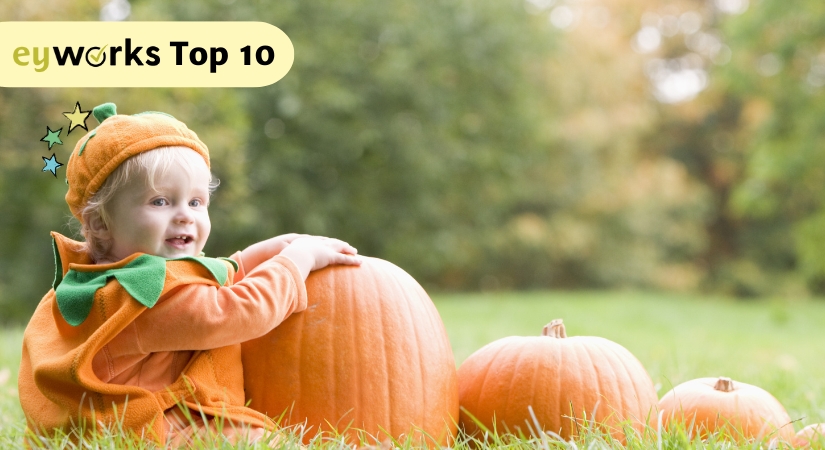Autumn has officially arrived in the UK, which brings a world of opportunities for fun and learning. With vibrant colours and crisp air, this season offers an array of engaging activities for babies and toddlers.
In this blog, we’ll explore 10 exciting autumn activities perfect for Early Years education that you can use in your setting. We’ll let you know what you need, what to do, and highlight the learning benefits each activity can have for both babies and toddlers. We’ll also share how the eyworks platform can support you throughout.
Skip to the good bits:
- Leafy Sensory Exploration
- Nature Walk and Autumn Scavenger Hunt
- Autumn Apple Tasting
- Seasonal Vegetable Exploration
- Bird Watching Adventure
- Seasonal Storytelling
- Pumpkin Playdough
- Outdoor Nature Art
- Autumn-themed Puppet Show
- Harvest Festival Celebration
1. Leafy Sensory Exploration
Creating a sensory bin filled with dry leaves for tactile exploration is a great autumn activity for babies and toddlers alike. Collect leaves from your nursery’s surroundings, and reuse containers for storage to make it eco-friendly too!
For Babies:
Lay a soft blanket on the floor and place the sensory bin filled with dry leaves nearby. Allow babies to sit, lie down, or crawl on the blanket and explore the leaves with their hands and feet. Encourage them to touch, crinkle, and feel the leaves’ textures. Use descriptive words like “soft,” “crunchy,” and “rustling” to engage their senses.
Learning Benefits:
- Sensory Exploration: This activity provides a rich sensory experience for babies. They can explore the dry leaves’ textures through touch, and they will also hear the leaves’ rustling sounds as they move or crinkle them. Sensory exploration is crucial for babies’ brain development.
- Tummy Time: For babies who are learning to crawl or sit up, lying on the soft blanket and reaching out to touch the leaves can encourage tummy time. Tummy time helps strengthen their neck and upper body muscles, an important milestone in physical development.
- Language Development: As practitioners use descriptive words like “soft,” “crunchy,” and “rustling” while engaging with the leaves, babies are exposed to a variety of language stimuli. Hearing and experiencing these words helps build their early vocabulary and language comprehension.
- Cognitive Development: Babies begin to understand cause and effect by manipulating the leaves. They learn that when they touch or crinkle the leaves, they create a sound or change the leaves’ shape, fostering cognitive development.
For Toddlers:
Set up the sensory bin at a low table or on the floor, providing a safe and comfortable space for toddlers to explore. Encourage them to use their fingers to pick up leaves, squish them, and let them fall. As they explore, engage them in conversation by asking questions like, “What does the leaf feel like?” or “Can you make a leaf pile?”
Introduce the concept of sorting by providing leaves of different shapes, colours, or sizes. Encourage the toddlers to group the leaves based on these characteristics.
Learning Benefits:
- Fine Motor Skills: Picking up and squishing leaves with their fingers is an excellent way for toddlers to refine their fine motor skills. These actions require precision and coordination, which are crucial for tasks like writing and self-feeding.
- Cognitive Skills: Introducing the concept of sorting by providing leaves of different shapes, colours, or sizes encourages cognitive development. Toddlers can engage in categorisation and problem-solving as they figure out how to group the leaves based on these characteristics.
- Language Development: Engaging in conversations with toddlers about the leaves, such as asking them to describe how a leaf feels or what colours they see, promotes language development. It encourages them to express themselves, expand their vocabulary, and understand concepts like size and colour.
- Maths Concepts: Sorting leaves based on different attributes (e.g. colour or shape) introduces early maths concepts such as classification and comparison. It lays the foundation for more complex mathematical thinking in the future.
- Creativity and Imagination: The open-ended nature of leaf play allows toddlers to use their creativity and imagination. They can use the leaves to create patterns, pretend they are making a “leaf soup” or engage in imaginative play, fostering creativity.
- Social Skills: If the activity is done in a group setting, it provides opportunities for social interaction, sharing, and cooperation. Toddlers can work together to sort the leaves, enhancing their social skills.

2.Nature Walk and Autumn Scavenger Hunt
Promote local green spaces and embark on a nature walk to explore the changing seasons and collect fallen leaves. Turn the nature walk into a scavenger hunt for natural treasures like acorns, conkers, and leaves for older children in your setting.
For Babies:
Secure babies in carriers or pushchairs, take them on a leisurely nature walk and point out natural treasures like leaves, acorns, or pinecones as you find them. Describe the sights, sounds, and smells of the outdoors, including the rustling leaves. Point out the leaves changing colours to introduce them to the concept of autumn.
Learning Benefits
- Sensory Stimulation: Going on a nature walk exposes babies to various sensory experiences. They can feel the gentle movement of the pushchair or carrier, listen to the sounds of nature, and smell the fresh outdoor air. These sensory inputs contribute to their sensory development.
- Language Development: Describing the natural treasures and the outdoor environment as you encounter them helps build your baby’s vocabulary. They begin to associate words with real-world objects and experiences. Additionally, pointing out the changing colours of leaves introduces them to the concept of autumn, expanding their understanding of the world.
- Bonding: The shared experience of a nature walk provides an opportunity for bonding between practitioners and babies. Talking to your baby, making eye contact, and sharing the wonders of nature can enhance the emotional connection between you and your child.
For Toddlers:
Create a scavenger hunt checklist with pictures of items like leaves, acorns, and twigs. Encourage toddlers to find and collect these items with your guidance. Encourage them to pick up items they find interesting. Engage them in discussions about the colours, shapes, and sizes of the items they collect.
Learning Benefits
- Observation and Exploration: The scavenger hunt activity encourages toddlers to be observant and actively explore their surroundings. It promotes curiosity and a sense of wonder as they search for natural items like leaves, acorns, and twigs.
- Fine Motor Skills: Picking up items of interest, such as leaves and twigs, strengthens toddlers’ fine motor skills. It requires them to use their fingers and hand muscles to grasp and hold objects, promoting dexterity.
- Cognitive Development: Engaging in discussions about the colours, shapes, and sizes of the items they collect fosters cognitive development. It helps them learn to categorise and differentiate objects based on various attributes.
- Nature Appreciation: By actively participating in the scavenger hunt and discussing the items they find, toddlers start to develop an appreciation for nature and its diversity. They learn to value the natural world around them.
- Problem-Solving: As toddlers work through the scavenger hunt checklist, they engage in problem-solving by matching the items they find to the pictures on the list. This critical thinking skill is valuable for their overall cognitive development.
- Communication Skills: Encouraging toddlers to talk about the items they find and share their observations with you promotes language development and effective communication. They learn to express themselves and engage in meaningful conversations.
- Independence: Allowing toddlers to pick up items they find interesting promotes a sense of independence and autonomy. They take ownership of their discoveries and develop a sense of accomplishment.

3. Autumn Apple Tasting
Another great autumn activity for kids is to introduce the little ones to different apple varieties through a taste-testing session. You can try sourcing apples from local farmers or markets to reduce transportation emissions and make this activity more eco-friendly. This simple yet engaging activity not only sharpens their senses and expands their palates but also creates lasting family memories.
For Babies:
Puree apples or slice apples into small, safe pieces and offer them to babies to touch, smell, and taste. Use descriptive words like “sweet,” “juicy,” and “crunchy” as you introduce them to different apple varieties.
Learning Benefits
- Sensory Exploration: Allowing babies to touch, smell, and taste different apple varieties offers a rich sensory experience. They can feel the textures of the apple slices, experience the aroma of fresh apples, and explore the taste and juiciness of the fruit. This sensory exploration is essential for their sensory development.
- Language Development: While introducing babies to different apple varieties, caregivers can use descriptive words like “sweet,” and “juicy.,” and “crunchy.” This helps build their early vocabulary and teaches them to associate words with sensory experiences, promoting language development.
- Fine Motor Skills: Picking up small pieces of apple and bringing them to their mouths encourages the development of fine motor skills. Babies practise grasping, bringing objects to their mouths, and coordinating hand-eye movements.
- Taste Exploration: Introducing babies to a variety of apple types helps them develop a diverse palate. They can learn to distinguish between sweet, tart, and different apple flavours, laying the foundation for healthy eating habits.
For Toddlers:
Create a tasting station with slices of various apple types. Encourage toddlers to use their senses to explore the apples. Ask open-ended questions like, “Which apple do you like best?” to promote language development.
Learning Benefits
- Sensory and Taste Exploration: Similar to babies, toddlers continue to benefit from sensory exploration when they engage with different apple varieties. They can further refine their sensory skills by comparing the textures, aromas, and tastes of these apples.
- Language Development: Encouraging toddlers to use their senses to explore the apples and asking open-ended questions like, “Which apple do you like best?” promotes language development. They learn to express their preferences and engage in meaningful conversations. Use an Early Years online learning journal to record updates to their language development.
- Cognitive Skills: Comparing and contrasting different apple types engages toddlers in cognitive processes. They begin to understand concepts like similarity and difference, which are fundamental cognitive skills.
- Decision-Making: Asking toddlers to choose their favourite apple encourages decision-making and independence. They learn to make choices based on their preferences, fostering a sense of autonomy.
- Healthy Eating Habits: This activity can help reinforce the idea of enjoying a variety of healthy foods. It encourages toddlers to explore new flavours and textures, promoting a positive attitude toward fruits and vegetables.
- Social Interaction: If done in a group or with peers, the activity promotes social interaction and sharing. Toddlers can discuss their preferences and share their thoughts with others, enhancing their social skills.
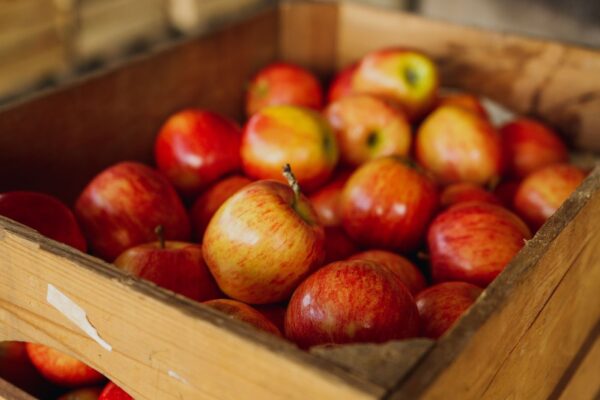
4. Seasonal Vegetable Exploration
Let the toddlers dive into a colourful world of seasonal veggies in all their quirky shapes and sizes. Gather a vibrant collection from local farms or community gardens, and don’t forget to hunt down some funky pumpkins at nearby pumpkin patches! Use software such as a parent engagement app to share fun pictures and seasonal memories with the parents of the children in your setting.
For Babies:
Arrange a safe outdoor area with seasonal vegetables like pumpkins, squash, and sweet potatoes for them to touch and explore. Describe the vegetable’s shapes, sizes, and colours as they interact with them.
Learning Benefits
- Sensory Exploration: Babies learn about the world primarily through their senses. Allowing them to touch and explore seasonal vegetables like pumpkins, squash, and sweet potatoes engages their sense of touch and helps them understand different textures and temperatures. This sensory exploration enhances their sensory development.
- Language Development: As babies interact with these vegetables, caregivers can describe the shapes, sizes, and colours of the vegetables they are touching. This verbal interaction helps build their vocabulary and understanding of descriptive words, promoting language development.
- Fine Motor Skills: Grasping and manipulating vegetables of various sizes and shapes can help develop fine motor skills. Babies can practise their pincer grasp as they pick up small pieces, enhancing their hand-eye coordination.
- Cognitive Development: Babies begin to learn about object permanence and cause-and-effect by observing how these vegetables respond to their touch. For example, when they squeeze a soft vegetable, they can feel it give way, which contributes to their understanding of the physical world.
For Toddlers:
Encourage toddlers to explore the vegetables by touching, feeling, and even gently rolling them. Provide the toddlers with safe kitchen tools like wooden spoons and cutters to engage in hands-on exploration. Encourage them to cut soft vegetables and describe the colours and smells. Provide opportunities for them to compare and contrast different vegetables.
Learning Benefits
- Sensory and Fine Motor Skills: Like babies, toddlers continue to benefit from sensory exploration, but they can engage in more complex activities. Rolling, squeezing, and even cutting soft vegetables with safe kitchen tools like wooden spoons and cutters enhance their fine motor skills. It also offers a hands-on experience that can be both enjoyable and educational.
- Cognitive Skills: Encouraging toddlers to compare and contrast different vegetables helps develop their cognitive skills. They learn to recognise similarities and differences, which is an essential cognitive ability. Additionally, they can begin to understand concepts like size, weight, and quantity.
- Language Development: As toddlers engage with the vegetables, caregivers can encourage them to describe what they see, feel, and smell. This process helps toddlers expand their vocabulary and express their observations and feelings.
- Creativity and Imagination: The open-ended nature of vegetable exploration allows toddlers to use their creativity and imagination. They might role-play with the vegetables, turning them into characters or objects, which fosters creativity and imaginative play.
- Social Skills: If this activity is done in a group setting, it can promote social skills such as sharing, taking turns, and cooperative play. Toddlers can learn to work together and communicate with their peers during the activity.
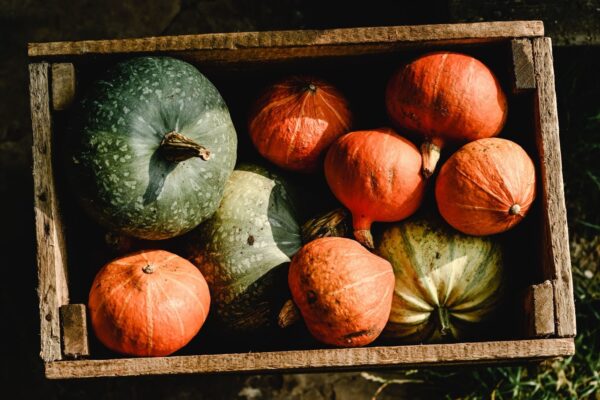
5. Bird Watching Adventure
Observing local birds and their behaviour is a wonderful way to foster curiosity about the natural world. You can set up a bird feeder or bird bath from recycled materials to attract a variety of feathered visitors.
For Babies:
Sit outdoors with babies and point out birds you see or hear. Use simple words like “bird” and “tweet” to introduce them to birdwatching.
Learning Benefits
- Sensory Stimulation: Being outdoors and observing birds engages babies’ senses. They can see the movement of birds, hear their chirping, and feel the warmth of the sun or the breeze on their skin, providing rich sensory experiences that contribute to their sensory development.
- Language Development: Pointing out birds and using simple words like “bird” and “tweet” helps babies build their early vocabulary. They begin to associate words with real-world objects and sounds, which promotes language development.
- Visual Tracking: Watching birds in flight or as they move around can help develop babies’ visual tracking skills. This is an important precursor to reading, as it involves following objects with their eyes.
For Toddlers:
Set up a bird-watching station with child-safe binoculars. Encourage toddlers to look for birds and describe what they see. Provide pictures of common birds to help them identify species.
Learning Benefits
- Sensory and Cognitive Skills: Bird-watching encourages toddlers to use their senses actively to observe and identify birds. They learn to distinguish different bird species based on visual and auditory cues, fostering sensory and cognitive development.
- Language Development: Encouraging toddlers to describe what they see when bird-watching promotes language development. They learn to express their observations and engage in conversations about the birds they encounter.
- Problem-Solving: Identifying different bird species and recognising their behaviours involves critical thinking and problem-solving. Toddlers learn to make connections and draw conclusions about the world around them.
- Visual Perception: Using child-safe binoculars helps toddlers refine their visual perception skills. They learn to focus on distant objects and make detailed observations, which is important for various aspects of visual processing.
- Nature Appreciation: Bird-watching fosters an early appreciation for nature and wildlife. Toddlers learn to respect and value the natural world, which can have positive long-term effects on their environmental awareness.
- Patience and Focus: Bird-watching often requires patience and focus, as birds may not always be immediately visible. Toddlers develop these skills as they wait and watch for birds to appear.
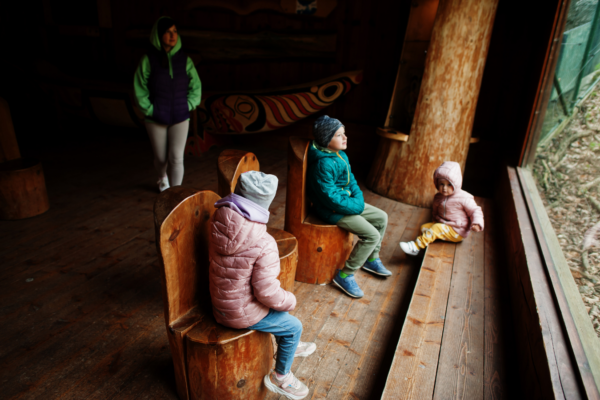
6. Seasonal Storytelling
Create a cosy reading nook with autumn-themed books for shared storytelling. Make use of your existing nursery books or borrow books from local libraries to save money on buying them new.
For Babies
Create a cosy reading nook with soft blankets and age-appropriate books with autumn-themed illustrations. Read aloud to babies and let them touch the pages.
Learning Benefits
- Language Development: Reading aloud to babies is one of the most effective ways to promote language development. Hearing words and sentences helps them develop listening and comprehension skills, as well as build their early vocabulary.
- Cognitive Development: Even though babies may not understand the content of the books, they benefit from exposure to various sounds, rhythms, and intonations of speech. This exposure lays the foundation for later cognitive and literacy skills.
- Sensory Stimulation: Allowing babies to touch the pages of age-appropriate books engages their sense of touch. They can feel the textures of different materials, such as cloth or board books, enhancing sensory development.
- Bonding: Reading together in a cosy reading nook fosters bonding between caregivers and babies. It’s a special time for cuddling, making eye contact, and sharing stories, which strengthens the emotional connection.
For Toddlers:
Encourage toddlers to choose books and participate in storytelling by pointing to pictures or repeating simple words. Create a warm and inviting atmosphere for shared reading.
- Some books we recommend are:
- The Gruffalo by Julia Donaldson
- We’re Going on a Bear Hunt by Michael Rosen
- Pumpkin Soup by Helen Cooper
- Fox’s Socks by Julia Donaldson
Learning Benefits
- Language and Communication Skills: Encouraging toddlers to choose books and participate in storytelling promotes language development. When they point to pictures or repeat simple words, they practise vocabulary and communication skills.
- Cognitive Skills: As toddlers engage with the pictures and storylines of books, they develop cognitive skills like comprehension, memory, and pattern recognition. They begin to understand cause-and-effect relationships in narratives.
- Early Literacy Skills: Shared reading experiences lay the foundation for early literacy skills. Toddlers start to understand how books work, including the concepts of reading from left to right and turning pages.
- Imagination and Creativity: Listening to and participating in storytelling allows toddlers to use their imagination and creativity. They can make connections between the story and their own experiences, fostering imaginative thinking.
- Attention Span: Reading books together helps toddlers extend their attention span as they become more engaged in longer stories. This is an important skill for school readiness.
- Emotional Development: Books often contain themes and emotions that toddlers can relate to. Reading stories about characters experiencing different feelings helps toddlers understand and express their own emotions.
- Empathy and Social Skills: Many children’s books teach lessons about empathy, kindness, and friendship. Toddlers can learn valuable social skills and emotional intelligence through these stories.
- Independence: Allowing toddlers to choose their own books empowers them to make decisions and exercise independence. It also encourages a love for books and reading.
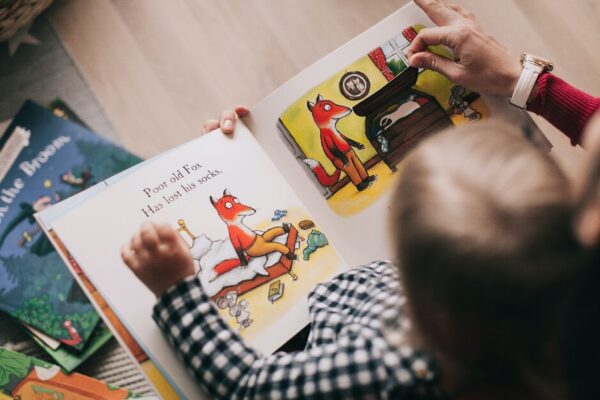
7. Pumpkin Playdough
Creating pumpkin-scented playdough for toddlers and babies is a great autumn activity and a way to engage their senses and encourage creative play. Not only does it provide a fun, hands-on experience but it also introduces little ones to the warm, comforting scents of autumn.
For Babies:
Offer babies pieces of pumpkin-scented playdough to explore with their hands. Describe the playdough’s texture and scent.
Learning Benefits
- Sensory Exploration: Offering babies pieces of pumpkin-scented playdough provides a rich sensory experience. They can explore the playdough’s texture through touch and experience the scent of pumpkin. Sensory exploration is crucial for their sensory development.
- Language Development: Describing the playdough’s texture and scent as you interact with it helps build your baby’s vocabulary. They begin to associate words with sensory experiences, promoting language development.
- Fine Motor Skills: Manipulating pieces of playdough encourages babies to use their fingers and hands, helping develop fine motor skills. This activity can strengthen their hand muscles and coordination.
- Cognitive Development: As babies touch and manipulate the playdough, they begin to understand basic cause-and-effect relationships. For example, when they squeeze the playdough, it changes shape, contributing to their cognitive development.
For Toddlers:
Provide toddlers with playdough and pumpkin-shaped cookie cutters. Encourage them to mould and shape the playdough into pumpkins or other autumn-themed items, a great photo opportunity to capture and share with parents!
Learning Benefits
- Fine Motor Skills: Using playdough and pumpkin-shaped cookie cutters encourages the development of fine motor skills. Toddlers practise hand strength, coordination, and finger dexterity as they mould and shape the playdough.
- Creativity and Imagination: Playdough is an open-ended material that allows toddlers to use their creativity and imagination. They can mould pumpkins, leaves, and other autumn-themed items, fostering imaginative thinking.
- Cognitive Skills: Moulding playdough into specific shapes, like pumpkins, promotes cognitive development. Toddlers learn to recognise and recreate familiar objects, which is an important cognitive skill.
- Problem-Solving: When toddlers use cookie cutters with playdough, they encounter challenges, such as figuring out how to press the cutter firmly or how to release the cut shape from the playdough. These situations promote problem-solving skills.
- Maths Concepts: Playing with playdough can introduce basic maths concepts, such as size and quantity. Toddlers may compare the sizes of their pumpkin shapes or count the number of shapes they make.
- Expressive Language: Encouraging toddlers to describe what they are creating or to tell a story with their playdough creations promotes expressive language skills. They learn to communicate their thoughts and ideas through play.
- Social Interaction: If done in a group setting, playing with playdough can promote social interaction and cooperation. Toddlers can share ideas, collaborate on projects, and engage in parallel or cooperative play.

8. Outdoor Nature Art
Setting up an outdoor art station with natural materials like twigs, leaves, and pinecones is a wonderful autumn activity for early years. This can encourage toddlers and babies to explore their creativity while connecting with nature.
For Babies:
Create a nature art display outdoors with leaves and other natural materials. Describe the colours and shapes of the artwork to babies as you explore it together.
Learning Benefits
- Sensory Exploration: Babies benefit from sensory exploration of nature art. They can touch and feel the textures of leaves and natural materials, experiencing various tactile sensations that contribute to their sensory development.
- Visual Stimulation: Observing the nature art display outdoors engages babies’ visual senses. They can look at the different colours and shapes in the artwork, which helps with visual development.
- Language Development: Describing the colours and shapes of the artwork to babies as you explore it together builds their early vocabulary and language skills. They begin to associate words with the objects and experiences in their environment.
- Nature Connection: Creating nature art outdoors introduces babies to the natural world and fosters an early connection with nature. They can begin to appreciate the beauty of natural materials and the outdoors.
For Toddlers:
Set up an outdoor art station with materials like twigs, leaves, and pinecones. Encourage toddlers to use these materials to create their own outdoor-themed art. Talk about their creations, using words like “nature” and “art.”
Learning Benefits
- Fine Motor Skills: Setting up an outdoor art station with materials like twigs, leaves, and pinecones encourages toddlers to use their fine motor skills. They manipulate these materials to create their own artwork, promoting hand-eye coordination and dexterity.
- Creativity and Imagination: Providing natural materials for art allows toddlers to use their creativity and imagination. They can experiment with different arrangements and combinations, fostering imaginative thinking.
- Cognitive Skills: Sorting and arranging natural materials for art engages cognitive skills. Toddlers learn to categorise and organise objects, which are fundamental cognitive abilities.
- Language Development: Encouraging toddlers to talk about their creations and describe their artwork using words like “nature” and “art” promotes language development. They learn to express themselves and communicate their ideas.
- Nature Appreciation: Creating nature-themed art encourages toddlers to appreciate the beauty and diversity of the natural world. They learn to see artistic potential in everyday natural materials.
- Self-Expression: Art allows toddlers to express themselves in a non-verbal way. They can communicate their thoughts, feelings, and experiences through their artwork, enhancing their self-expression.
- Sense of Accomplishment: Completing an art project gives toddlers a sense of accomplishment and pride. It helps build their self-esteem and confidence.
- Social Interaction: If done in a group setting, outdoor art activities can promote social interaction and cooperation. Toddlers can share materials, collaborate on projects, and engage in parallel or cooperative play.
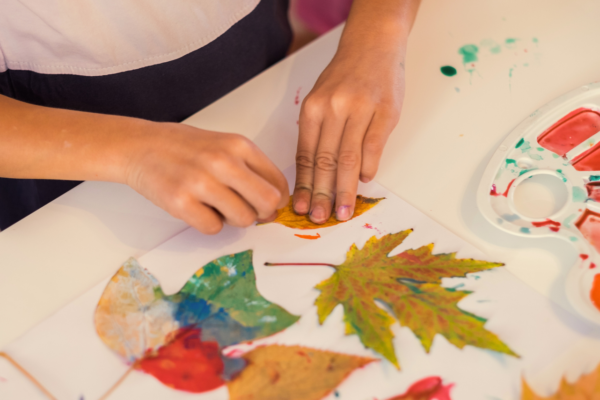
9. Autumn-themed Puppet Show
Create a puppet show with autumn-themed characters and stories such as friendly squirrels gathering acorns, wise old owls and playful pumpkins. Craft your own puppets from recycled materials to stay eco-friendly and keep it budget-friendly.
For Babies:
Perform a simple puppet show with autumn-themed puppets while babies watch. Use gentle voices and simple actions to engage babies’ attention.
Learning Benefits
- Visual Stimulation: Watching a puppet show engages babies’ visual senses. The use of colourful and autumn-themed puppets can captivate their attention and stimulate their visual development.
- Auditory Stimulation: Listening to caregivers’ gentle voices during the puppet show provides auditory stimulation for babies. They become familiar with different tones and inflections, which contributes to their language development.
- Social Interaction: Puppet shows offer opportunities for social interaction between caregivers and babies. Babies can make eye contact with the caregivers, watch their movements, and respond with gestures or sounds, enhancing social engagement.
- Narrative Skills: Even at a young age, babies can begin to absorb the concept of storytelling through puppet shows. They start to recognise patterns and sequences in the narrative, which is an early form of understanding stories.
For Toddlers:
Encourage toddlers to participate in the puppet show by providing them with their own puppets or stuffed animals. Let them take turns playing different characters and using their imaginations.
Learning Benefits
- Creativity and Imagination: Encouraging toddlers to participate in the puppet show allows them to use their creativity and imagination. They can invent stories, dialogue, and actions for their puppets, fostering imaginative thinking.
- Language Development: When toddlers take on different puppet characters, they have the opportunity to engage in imaginative role-playing and storytelling. This promotes language development as they use words and expressions to represent the characters.
- Social and Emotional Skills: Playing with puppets and engaging in puppet shows can help toddlers express their emotions and practise social skills. They can use the puppets to act out various emotional scenarios, helping them understand and manage their feelings.
- Fine Motor Skills: Manipulating the puppets requires fine motor skills. Toddlers use their fingers and hand muscles to control the puppets’ movements, which is essential for dexterity.
- Self-Expression: Puppet shows provide an outlet for self-expression. Toddlers can use the puppets to express themselves, share their thoughts, and act out situations they might not otherwise be able to communicate.
- Cognitive Development: Participating in puppet shows helps toddlers develop cognitive skills such as memory and sequencing. They remember the storyline, actions, and dialogues for their puppet characters.
- Narrative Skills: Playing with puppets and engaging in storytelling contributes to toddlers’ narrative skills. They learn about story structure, character development, and cause-and-effect relationships within a narrative.
- Social Interaction: Puppet shows also promote social interaction among toddlers. They can take turns, cooperate with peers in storytelling, and learn the importance of listening to others.
eyworks tip: Share your puppet mastery and creation tips and tricks with other parents through eyparent.

10. Harvest Festival Celebration
A mini-harvest festival is a perfect way to immerse toddlers and babies in the spirit of the autumn season, turning it into a memorable experience filled with joy, learning, and community. You can tailor the festival to engage their senses and introduce them to the joys of the autumn season in a fun and interactive way.
For Babies:
Arrange a festive indoor space with seasonal decorations, such as paper pumpkins and autumn-coloured streamers. Describe the colours and shapes of the decorations to babies.
Learning Benefits
- Sensory Stimulation: Babies benefit from sensory experiences, and festive decorations provide opportunities for sensory exploration. They can touch and feel the textures of paper pumpkins and streamers, enhancing their sensory development.
- Visual Stimulation: Festive decorations engage babies’ visual senses. They can look at the vibrant colours and shapes of the decorations, promoting visual development.
- Language Development: Describing the colours and shapes of the decorations to babies as you interact with them helps build their early vocabulary. They begin to associate words with the objects and experiences in their environment.
- Social Interaction: Creating a festive indoor space offers opportunities for social interaction between caregivers and babies. Babies can make eye contact with caregivers, watch their movements, and respond with gestures or sounds, enhancing social engagement.
For Toddlers:
Engage toddlers in simple harvest-themed crafts such as decorating paper pumpkins, and join in with harvest-themed singing and music-making. Encourage them to participate in the festive atmosphere.
Learning Benefits
- Fine Motor Skills: Engaging in harvest-themed crafts, such as decorating paper pumpkins, encourages toddlers to use their fine motor skills. They practise precise movements as they handle craft materials, promoting hand-eye coordination and dexterity.
- Creativity and Imagination: Participating in craft activities allows toddlers to use their creativity and imagination. They can explore different ways to decorate pumpkins, fostering imaginative thinking.
- Cognitive Development: Crafting involves cognitive skills such as planning, decision-making, and problem-solving. Toddlers learn to make choices about how to decorate their crafts and solve minor challenges they encounter during the process.
- Language Development: Encouraging toddlers to talk about their crafts and the festive atmosphere promotes language development. They learn to express themselves and communicate their ideas and experiences.
- Sensory Exploration: Craft materials often have unique textures and qualities. Toddlers can explore the sensory aspects of materials like coloured paper, glue, and paint, enriching their sensory experiences.
- Pride and Self-Expression: Completing craft projects gives toddlers a sense of accomplishment and pride. They can express themselves creatively through their crafts, enhancing self-expression.
- Narrative Skills: Engaging in craft activities offers opportunities for storytelling and narrative skills. Toddlers can create stories or explanations about their crafts, promoting narrative development.
- Emotional Expression: Crafting allows toddlers to express their emotions through their creations. They may choose colours or designs that reflect their feelings or experiences, helping them understand and communicate emotions.
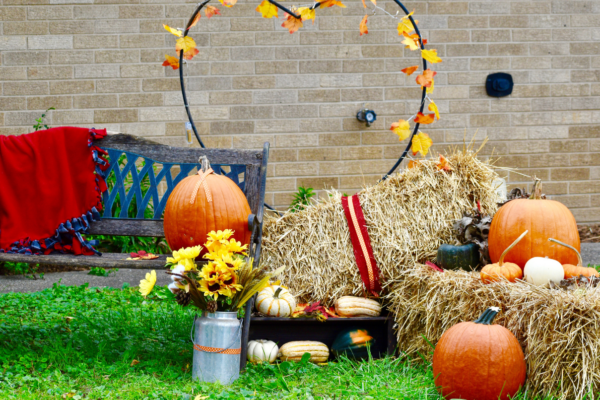
These 10 children’s activities for autumn offer an abundance of learning opportunities for babies and toddlers at your nursery. By incorporating these ideas into your nursery’s curriculum, you can help young children connect with nature, build essential skills, and develop a lifelong love for learning. So, get ready for a season of discovery, exploration, and loads of autumnal fun!
Do You Need More Time to Plan Your Autumn Activities at Nursery?
At eyworks, we offer a suite of tools and nursery management software that help you streamline administative tasks and save time. If you would like to learn more about how we can help you spend less time on admin and more on creating enhanced learning experiences for the children at your nursery, contact our team at hello@eywork.co.uk.
